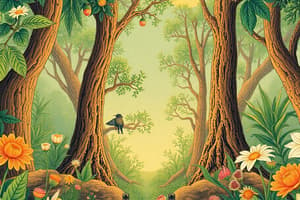Podcast
Questions and Answers
Which of the following best describes biodiversity?
Which of the following best describes biodiversity?
- The total number of individuals in a species
- The genetic makeup of a single organism
- The variety of living organisms in an ecosystem (correct)
- The interactions between living organisms and their physical environment
In an ecosystem, what is the significance of mutualism?
In an ecosystem, what is the significance of mutualism?
- It involves competition for resources among organisms
- It is a relationship where both organisms benefit (correct)
- It causes harm to both interacting species
- It leads to the extinction of species
How does natural selection contribute to evolutionary changes?
How does natural selection contribute to evolutionary changes?
- It eliminates genetic variation within a population
- It directly manipulates an organism's genes
- It accelerates the mutation rate in a species
- It favors traits that increase an organism's chances of survival and reproduction (correct)
What role does adaptation play in the survival of species?
What role does adaptation play in the survival of species?
How do ecosystems maintain stability and balance?
How do ecosystems maintain stability and balance?
Which concept describes features that improve the ability of an organism to survive and reproduce in its environment?
Which concept describes features that improve the ability of an organism to survive and reproduce in its environment?
What principle in evolutionary biology explains the process through which populations change gradually over generations?
What principle in evolutionary biology explains the process through which populations change gradually over generations?
What are the hierarchical classification schemes used by biologists to communicate clearly about organisms?
What are the hierarchical classification schemes used by biologists to communicate clearly about organisms?
Which process causes certain traits that increase the likelihood of survival and reproduction to become more common over time?
Which process causes certain traits that increase the likelihood of survival and reproduction to become more common over time?
What are the structural, behavioral, and physiological features that can evolve through natural selection called?
What are the structural, behavioral, and physiological features that can evolve through natural selection called?
Flashcards are hidden until you start studying
Study Notes
Living World: Understanding Biodiversity, Ecosystems, Classification, Natural Selection, Adaptations
The living world is incredibly diverse and interconnected, with millions of species inhabiting our planet in various habitats and environments. To better understand this complex system, let's explore some key concepts related to the living world: biodiversity, ecosystems, classification, natural selection, and adaptations.
Biodiversity
Biodiversity refers to the variety of life on Earth, including the wide range of plant and animal species, as well as microorganisms like bacteria and fungi. It represents the different forms of life within our environment, their genetic makeup, and the roles they play in maintaining ecological balance. A high level of biodiversity indicates the health of an ecosystem because it means there is a good mix of organisms capable of responding effectively to environmental changes.
Ecosystems
An ecosystem consists of all the living organisms in a particular area interacting together along with the physical components such as soil, water, sunlight, etc.. These interactions occur between plants, animals, and other organisms through processes like photosynthesis, decomposition, predation, parasitism, competition, mutualism, and symbiosis. This intricate web of relationships ensures a stable and balanced environment where each component plays its part in maintaining the entire system.
Classification
Classification systems help us organize and make sense of the vast array of biological entities on our planet. They allow scientists to identify, name, describe, sort out, group, and distinguish among the myriad living things we encounter daily. These hierarchical classification schemes, ranging from kingdoms down to families and genera, enable biologists to communicate clearly about organisms and facilitate comparisons across groups.
Natural Selection
Natural selection is one of the most fundamental principles in evolutionary biology. It describes how certain traits that increase the likelihood of survival and reproduction will become more common over time due to differential reproductive success. In essence, this process causes populations to change gradually over generations if certain individuals have heritable characteristics that better fit them to survive and reproduce in their specific environment.
Adaptations
Adaptations are features that improve the ability of an organism to survive and reproduce in its environment. They can evolve through natural selection when an individual possesses a trait that increases their chances of surviving and passing on those genes to subsequent generations. Adaptations often take many forms, from structural elements like body shape and coloration to behavioral patterns and physiological responses.
Understanding these key concepts—biodiversity, ecosystems, classification, natural selection, and adaptations—can deepen our appreciation for the complexities and beauty of the living world around us. By appreciating the interdependence of organisms in ecosystems and recognizing the role played by these concepts in shaping life on Earth, we gain insights into the wonders of nature and the importance of conservation efforts designed to preserve global biodiversity.
Studying That Suits You
Use AI to generate personalized quizzes and flashcards to suit your learning preferences.




